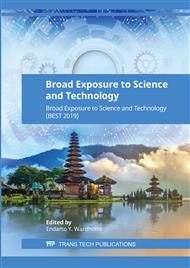[1]
R. Krishna Alla, K. Ginjupalli, N. Upadhya, M. Shammas, R. Krishna Ravi, and R. Sekhar, Surface roughness of implants: A review, Trends Biomater. Artif. Organs. 25 (2011) 112–118.
Google Scholar
[2]
D. D. Bosshardt, V. Chappuis, and D. Buser, Osseointegration of titanium, titanium alloy and zirconia dental implants: current knowledge and open questions, Periodontol. 73 (2017) 22–40.
DOI: 10.1111/prd.12179
Google Scholar
[3]
D. Apostu, O. Lucaciu, C. Berce, D. Lucaciu, and D. Cosma, Current methods of preventing aseptic loosening and improving osseointegration of titanium implants in cementless total hip arthroplasty: a review, J. Int. Med. Res. 46 (2018) 2104–2119.
DOI: 10.1177/0300060517732697
Google Scholar
[4]
J. N. Katz, J. Wright, E. A. Wright, and E. Losina, Failures of Total Hip Replacement: A Population-Based Perspective, Orthop J Harvard Med. Sch. 9 (2007) 101–106.
Google Scholar
[5]
D. Khang, J. Lu, C. Yao, K. M. Haberstroh, and T. J. Webster, The role of nanometer and sub-micron surface features on vascular and bone cell adhesion on titanium, Biomaterials, 29 (2008) 970–983.
DOI: 10.1016/j.biomaterials.2007.11.009
Google Scholar
[6]
P. Kreshanti, N. Tunjung, and A. Dionisius, The usability of locally-made miniplate and screw compared to the existing imported miniplate and screw The Usability of Locally-Made Miniplate and Screw Compared to The Existing Imported Miniplate and Screw, AIP Conference Proceedings 2092, 020032 (2019) 1-8.
DOI: 10.1063/1.5096700
Google Scholar
[7]
N. Qosim, S. Supriadi, P. Puspitasari, and P. Kreshanti, Mechanical Surface Treatments of Ti-6Al-4V Miniplate Implant Manufactured by Electrical Discharge Machining, 31 (2018) 1103–1108.
DOI: 10.5829/ije.2018.31.07a.14
Google Scholar
[8]
N. Qosim, S. Supriyadi, A. S. Saragih, Y. Whulanza, Surface treatments of ti-alloy based bone implant manufactured by electrical, Ingeniería Y Universidad: Engineering For Development, 2769 (2018) 1-12.
DOI: 10.11144/javeriana.iyu22-2.sttb
Google Scholar
[9]
H. Zeidler, F. Boettger-Hiller, J. Edelmann, and A. Schubert, Surface Finish Machining of Medical Parts Using Plasma Electrolytic Polishing, Procedia CIRP, 49 (2016) 83–87.
DOI: 10.1016/j.procir.2015.07.038
Google Scholar
[10]
A. Hana, Pembentukan Nanotube dan Penyalutan Komposit Hidroksiapatit-Polivinil-Alkohol-Kolagen pada Paduan Logam Ti-6Al-4V, Bogor, (2018).
Google Scholar
[11]
E. V. Parfenov, A. Yerokhin, R. R. Nevyantseva, M. V. Gorbatkov, C. J. Liang, and A. Matthews, Towards smart electrolytic plasma technologies: An overview of methodological approaches to process modelling," Surf. Coatings Technol., 269 (2015) 2–22.
DOI: 10.1016/j.surfcoat.2015.02.019
Google Scholar
[12]
K. Nestler, F. Böttger-Hiller, W. Adamitzki, G. Glowa, H. Zeidler, and A. Schubert, Plasma Electrolytic Polishing - An Overview of Applied Technologies and Current Challenges to Extend the Polishable Material Range, Procedia CIRP, 42 (2016) 503–507.
DOI: 10.1016/j.procir.2016.02.240
Google Scholar
[13]
M. Cornelsen, C. Deutsch, and H. Seitz, Electrolytic Plasma Polishing of Pipe Inner Surfaces, Metals (Basel), 8 (2017) 12.
DOI: 10.3390/met8010012
Google Scholar
[14]
N. Qosim, S. Supriadi, J. Istiyanto, A. S. Saragih, and Y. Whulanza, Surface Characteristics of Ti6Al4V-EDM Implant Engineered by PVD Coated-Etching and Acidithiobacillus Ferrooxidans Based-Biomachining, 020005 (2018) 5–10.
DOI: 10.1063/1.5051974
Google Scholar
[15]
S. K. Sen Gupta, Contact Glow Discharge Electrolysis: Its Origin, Plasma Diagnostics and Non-Faradaic Chemical Effects, Plasma Sources Sci. Technol. 24 (2015) 063001.
DOI: 10.1088/0963-0252/24/6/063001
Google Scholar
[16]
M. B. Štefan Podhorsky, Plasma Polishing of Stainless Steel – The Electrolyte Concentration vs Gloss Level, Res. Pap. Fac. Mater. Sci. Technol. 26 (2018) 171–176.
Google Scholar
[17]
A. V Zhirov, S. Y. Shadrin, and P. N. Belkin, Effects of Electrolyte Composition on Heat Exchange in Anode Plasma Electrolyte Treatment of Commercial Titanium 1, 54 (2018) 136–141.
DOI: 10.3103/s1068375518020151
Google Scholar
[18]
D. Zhai, K. Feng, and H. Yue, Growth Kinetics of Microarc Oxidation TiO 2 Ceramic Film on Ti6Al4V Alloy in Tetraborate Electrolyte, Metall. Mater. Trans. A, 50 (2019) 2507–2518.
DOI: 10.1007/s11661-019-05185-1
Google Scholar
[19]
C. Nair, Effect of Different Polishing Agents on Surface Finish and Hardness of Denture Base Acrylic Resins: A Comparative Study, Int. Journal of Prosthodontics and Restorative Dentistry, 1 (2011) 7-10.
DOI: 10.5005/jp-journals-10019-1002
Google Scholar


